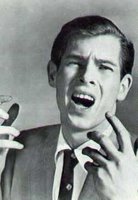 Johnnie Ray born 10 January 1927 (d. 1990)
Johnnie Ray born 10 January 1927 (d. 1990)John Alvin Ray was an American singer, songwriter and pianist.
He was one of the most popular American singers of his day, and is considered by many people to be the forerunner of what would become rock 'n' roll.
Ray first attracted attention while performing at the Flame Showbar in Detroit, an R&B nightclub where he was the only white performer - he was in fact part-Native American. Inspired by rhythm singers like Kay Starr, LaVern Baker and Ivory Joe Hunter, Ray developed a unique rhythm-based style that was far closer to what would become known as 'rock and roll' than any other music of the time. Much like Frankie Laine before him, he was often mistaken for a black artist when his records first started hitting the airwaves.
His first record, the self-penned R&B number for OKeh Records, Whiskey and Gin, was a minor hit in 1951, but by the end of the year he would be dominating the charts with the double-sided monster hit single of Cry backed by The Little White Cloud That Cried (the latter also a Ray composition). His emotional delivery struck a chord with teenagers, and he quickly became the biggest teen idol since Frank Sinatra almost ten years earlier. Ray has been cited as the historical link between Frank Sinatra and Elvis Presley in the development of popular music.
 Ray's unorthodox performing style included many theatrics later associated with rock 'n' roll, including beating up his piano, writhing on the floor and, most famously, crying. Also like Laine, his shows were often compared to religious revival meetings with the singer and audience both reaching an emotional frenzy. Ray quickly earned a plethora of nicknames including 'The Atomic Ray', 'Mr. Emotion', 'The Nabob of Sob', 'The Cry Guy' and 'The Prince of Wails'.
Ray's unorthodox performing style included many theatrics later associated with rock 'n' roll, including beating up his piano, writhing on the floor and, most famously, crying. Also like Laine, his shows were often compared to religious revival meetings with the singer and audience both reaching an emotional frenzy. Ray quickly earned a plethora of nicknames including 'The Atomic Ray', 'Mr. Emotion', 'The Nabob of Sob', 'The Cry Guy' and 'The Prince of Wails'.More hits followed. He was even more popular in the UK than in the US, breaking the record at the London Palladium formerly set by Frankie Laine. Although his star rapidly diminished in the US, he retained a loyal fan base overseas, particularly in Australia.
As wild off the stage as on, Ray soon became fodder for tabloids like Confidential and Hush-Hush which conspired to destroy his phenomenal popularity (at one point he had four of the top songs on the charts in one week out of the US Top Ten). But, ironically, he was ultimately a victim of the rock 'n' roll genre he did so much to establish. As younger and younger artists came to dominate the charts, the thirty-something Johnnie Ray was soon left by the wayside.
Though Ray married Marilyn Morrison in 1952, his wife was well aware of the singer's homosexuality. She believed she would be able to 'straighten it out'. But some years later, his manager Bill Franklin became Ray's lover. Rumored to be bisexual, the singer was prosecuted for indecency in a public toilet. When he was arrested in 1959, there was much gossip about his homosexual leanings. This took a toll on Ray's popularity and contributed to the decline of his career.
His career revived in the 1970s, but it is only since the late 1990s that he has gained a great deal of recognition. A chronic and lifelong alcoholic, he died of liver failure in Los Angeles at the age of 63.